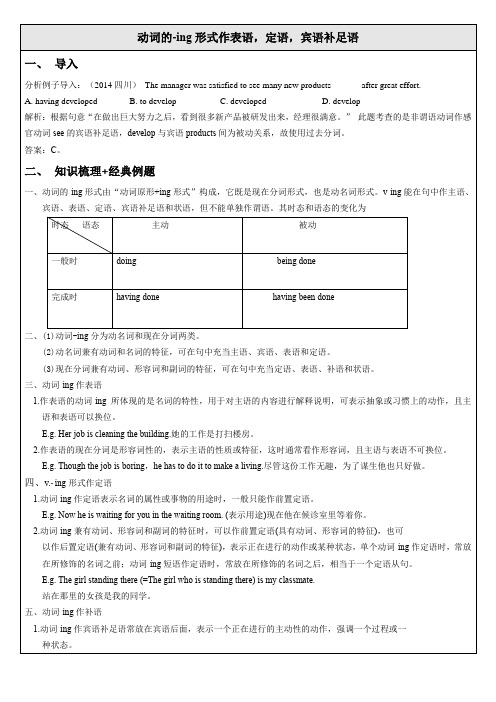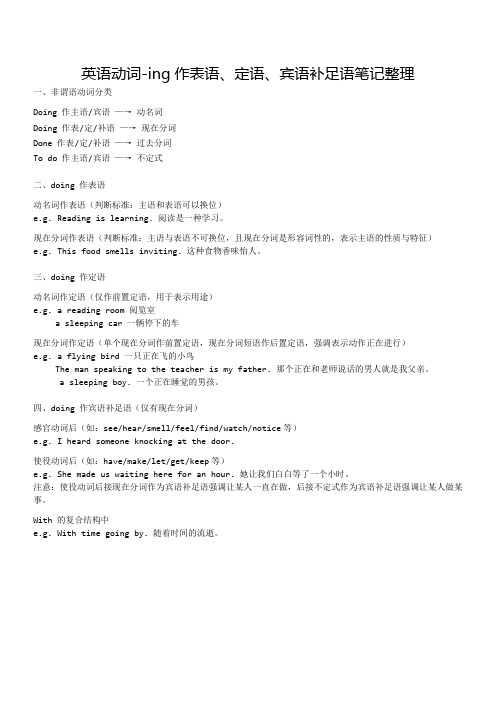动词ing形式作表语、定语和宾补
必修4动词-ing形式作表语、定语、宾语补足语和状语

年级高一学科英语版本人教实验版内容标题必修4 Unit 3 A taste of English humor动词-ing形式作表语、定语、宾语补足语和状语编稿老师林静【本讲教育信息】一. 教学内容:动词-ing形式作表语、定语、宾语补足语和状语二. 知识精讲(一)动词的ing形式作表语1. 动名词作表语一般表示抽象的、习惯性的行为,这时主语与表语的位置可以互换。
Her duty is taking care of the babies.照看婴儿是她的职责。
Our job is playing all kinds of music.我们的工作就是演奏各种音乐2. 现在分词作表语,表明的是主语的性质与特征,相当于形容词,可有比较级形式,亦可被very, quite,so等副词修饰,这时主语与表语的位置不可互换The music they are playing sounds exciting.他们演奏的音乐是如此令人兴奋The film we saw last night is quite moving.我们昨晚看的电影十分感人。
(二)动词的ing形式作定语1. 动名词作定语,表示该名词的用途或与其有关的动作,通常只能放在所修饰的名词前。
a walking stick手杖 reading room 阅览室 washing machine洗衣机2.现在分词作定语,说明所修饰的名词正在进行的动作或存在的状态,现在分词与所修饰的名词具有逻辑上的主谓关系,可换成定语从句来表达,单个的现在分词作定语常置于被修饰的名词前,现在分词短语作定语须置于被修饰的名词后。
Nobody can stop the running horse(=the horse that is running).没人能阻止那匹奔跑的马。
The student making the experiment(=who is making the experiment) is our monitor.正在做实验的那个学生是我们的班长。
动词的-ing形式作表语,定语,宾语补足语

1)位于感官动词后(see,hear,feel,smell,watch,find,notice等)。
E.g.I felt somebody patting me on the shoulder.我感到有人拍我的肩膀。
动词的-ing形式作表语,定语,宾语补足语
一、导入
分析例子导入:(2014四川)The managerwas satisfied to see many new products ______ after great effort.
A. having developedB. to develop C. developedD. develop
时态语态
主动
被动
一般时
doing
being done
完成时
having done
having been done
二、(1)动词-ing分为动名词和现在分词两类。
(2)动名词兼有动词和名词的特征,可在句中充当主语、宾语、表语和定语。
(3)现在分词兼有动词、形容词和副词的特征,可在句中充当定语、表语、补语和状语。
2.动词-ing兼有动词、形容词和副词的特征时,可以作前置定语(具有动词、形容词的特征),也可
以作后置定语(兼有动词、形容词和副词的特征),表示正在进行的动作或某种状态,单个动词-ing作定语时,常放在所修饰的名词之前;动词-ing短语作定语时,常放在所修饰的名词之后,相当于一个定语从句。
E.g.The girl standing there (=The girl who is standing there) is my classmate.
英语动词-ing作表语、定语、宾语补足语

英语动词-ing作表语、定语、宾语补足语笔记整理一、非谓语动词分类Doing作主语/宾语—→动名词Doing 作表/定/补语—→现在分词Done 作表/定/补语—→过去分词To do 作主语/宾语—→不定式二、doing 作表语动名词作表语(判断标准:主语和表语可以换位)e.g. Reading is learning. 阅读是一种学习。
现在分词作表语(判断标准:主语与表语不可换位,且现在分词是形容词性的,表示主语的性质与特征)e.g. This food smells inviting. 这种食物香味怡人。
三、doing 作定语动名词作定语(仅作前置定语,用于表示用途)e.g. a reading room 阅览室a sleeping car 一辆停下的车现在分词作定语(单个现在分词作前置定语,现在分词短语作后置定语,强调表示动作正在进行)e.g. a flying bird 一只正在飞的小鸟The man speaking to the teacher is my father. 那个正在和老师说话的男人就是我父亲。
a sleeping boy. 一个正在睡觉的男孩。
四、doing 作宾语补足语(仅有现在分词)感官动词后(如:see/hear/smell/feel/find/watch/notice等)e.g. I heard someone knocking at the door.使役动词后(如:have/make/let/get/keep等)e.g. She made us waiting here for an hour. 她让我们白白等了一个小时。
注意:使役动词后接现在分词作为宾语补足语强调让某人一直在做,后接不定式作为宾语补足语强调让某人做某事。
With 的复合结构中e.g. With time going by. 随着时间的流逝。
PartⅡGrammar——动词ing形式作表语定语和宾语补足语

PartⅡGrammar——动词ing形式作表语定语和宾语补⾜语Part ⅡGrammar——动词-ing形式作表语、定语和宾语补⾜语[思维导图]⼀、动词-ing形式作表语作表语的动词-ing形式包括现在分词和动名词。
1.现在分词作表语,往往具有形容词的性质,说明主语的性质、特征等。
The result of the game was disappointing.⽐赛结果令⼈失望。
His life story sounds very moving.他的⼈⽣故事听起来很感⼈。
[名师点津]作表语的现在分词,许多是由能够表⽰⼈们某种感情或情绪的动词变化⽽来的。
常见的有:moving,interesting,encouraging,exciting,inspiring,boring,surprising,puzzling,amusing,astonishing...这类分词有“令⼈……的”的含义,常修饰物。
2.动名词作表语多表⽰抽象性的或习惯性的动作,⼀般说明主语的内容。
What I am tired of is waiting here alone.我厌烦独⾃在这⾥等。
My hobby is collecting stamps.我的爱好就是集邮。
⼆、动词-ing形式作定语动名词和现在分词都可以作定语,但有所区别。
1.动名词作定语表⽰被修饰词的某种性能或⽤途,相当于for引导的介词短语。
No one is allowed to speak aloud in the reading room.阅览室⾥不准⼤声说话。
2.现在分词作定语时,它和被修饰词之间有逻辑上的主动关系,表⽰所修饰词进⾏的动作,相当于⼀个定语从句。
The boy playing football on the playground is my younger brother.=The boy that/who is playing football on the playground is my younger brother.在操场上踢⾜球的那个男孩是我的弟弟。
高中英语动词ing形式作表语定语宾语补足语和状语教案新人教版必修

高中英语动词ing形式作表语定语宾语补足语和状语教案新人教版必修一、教学目标1. 让学生掌握动词ing形式在句子中的不同作用,包括作表语、定语、宾语、补足语和状语。
2. 培养学生正确运用动词ing形式的能力,提高他们的英语写作和口语水平。
3. 通过实例分析,让学生了解动词ing形式在实际语境中的应用,增强他们的语言实践能力。
二、教学内容1. 动词ing形式作表语:表示正在进行的动作或状态。
2. 动词ing形式作定语:修饰名词或代词,表示事物的特征或状态。
3. 动词ing形式作宾语:表示动作的承受者。
4. 动词ing形式作补足语:补充说明宾语的状况或程度。
5. 动词ing形式作状语:表示时间、原因、条件等。
三、教学重点与难点1. 重点:动词ing形式在句子中的不同作用及用法。
2. 难点:区分动词ing形式与其他词性的用法,以及在不同语境中的运用。
四、教学方法1. 实例分析:通过大量例句,让学生了解动词ing形式的用法。
2. 互动讨论:鼓励学生积极参与,提问、回答问题,提高他们的口语表达能力。
3. 练习巩固:设计相关练习题,让学生在实际操作中掌握动词ing形式的用法。
五、教学步骤1. 引入:引导学生回顾动词的基本形式,为新课学习做好铺垫。
2. 讲解:讲解动词ing形式在句子中的不同作用,包括作表语、定语、宾语、补足语和状语。
3. 实例分析:分析具体例句,让学生了解动词ing形式的用法。
4. 互动讨论:分组讨论,让学生运用动词ing形式进行口语表达。
5. 练习巩固:布置练习题,让学生巩固所学知识。
6. 总结:对本节课内容进行总结,强调动词ing形式的重要性和应用。
7. 作业布置:设计相关作业,让学生课后巩固所学知识。
六、教学拓展1. 让学生了解动词ing形式在特定语境中的特殊用法,如固定搭配、被动语态等。
2. 引导学生关注动词ing形式在现实生活中的应用,提高他们的语言感知能力。
七、实践与应用1. 设计场景:创设现实生活中的场景,让学生运用动词ing形式进行口语表达。
动词-ing形式作表语定语,宾补及状语的用法

动词-ing形式作表语定语,宾补及状语的用法一、动词-ing形式作表语1.表示主语的内容,可以转换到句首作主语Her job is keeping the lecture hall as clean as possible. (= keeping the lecture hall as clean as possible is her job)她的工作是尽量使报告厅保持干净。
2.表示主语具有的特征、性质和状态(动词ing相当一个形容词)The problem is quite puzzling.这个问题很令困惑。
3.常用来作表语的现在分词有astonishing, amusing, confusing, disappointing, boring, encouraging, inspiring, moving, tiring, interesting, surprising等。
全析提示:动词-ing形式作表语时,其逻辑主语往往是句子中的主语,但用作表语的-ing形式也可带有自己的逻辑主语。
What worries me most is her staying too late every night. (staying too late every night的逻辑主语是her)二、动词-ing形式作定语1单个的动词-ing形式可以作前置定语,一般具有两种含义。
①说明被修饰名词的用途和性能。
a reading room = a room which is used for reading 阅览室running shoes =shoes for running 跑鞋a working method =a method for working 工作方法②表示所修饰的人或物的动作或状态,在意思上接近一个定语从句,可以表示正在进行的动作,也可表示经常性动作或当时的状态。
developing countries = countries that are developing发展中国家an ordinary-looking house = a house that looks ordinary看起来很普通的房子a puzzling problem = a problem that puzzles somebody困扰人的问题2作定语的动词-ing形式如是一个短语,则应放在被修饰词的后面,做后置定语,相当于一个定语从句。
高中英语动词ing形式作表语定语宾语补足语和状语教案新人教版必修

高中英语动词ing形式作表语、定语、宾语、补足语和状语教案新人教版必修一、教学目标1. 让学生掌握动词ing形式在句子中的基本用法,包括作表语、定语、宾语、补足语和状语。
2. 培养学生正确运用动词ing形式进行句型构建和句子分析的能力。
3. 提高学生对英语句子结构的认知,增强英语语法运用能力。
二、教学内容1. 动词ing形式作表语:表示正在进行的动作或状态。
2. 动词ing形式作定语:修饰名词,表示事物的特征或状态。
3. 动词ing形式作宾语:表示动作的承受者。
4. 动词ing形式作补足语:补充说明宾语的状况或动作。
5. 动词ing形式作状语:表示时间、原因、条件等。
三、教学重点与难点1. 重点:动词ing形式在句子中的五种用法。
2. 难点:动词ing形式作状语的用法和意义。
四、教学方法1. 实例分析:通过大量例句,让学生直观地了解动词ing形式的用法。
2. 练习巩固:设计不同类型的练习题,让学生在实践中掌握动词ing形式的用法。
3. 小组讨论:分组讨论,引导学生主动探索和发现动词ing形式的规律。
五、教学步骤1. 引入:以一段对话或故事引出动词ing形式,激发学生兴趣。
2. 讲解:详细讲解动词ing形式作表语、定语、宾语、补足语和状语的用法。
3. 举例:给出典型例句,分析并解释动词ing形式在不同用法中的含义。
4. 练习:让学生完成相关练习题,检验对动词ing形式用法的掌握程度。
6. 作业布置:设计课后作业,巩固所学内容。
7. 课后反思:教师对本节课的教学效果进行反思,为下一步教学做好准备。
六、教学拓展1. 引导学生运用动词ing形式进行句子创新,提高语言运用能力。
2. 对比分析动词ing形式和动词-ing形式在意义和用法上的差异。
3. 介绍动词ing形式在英语写作中的作用,提高学生写作水平。
七、课堂互动1. 提问:让学生回答关于动词ing形式的问题,加深对知识点的理解。
2. 讨论:组织学生就动词ing形式的用法展开讨论,分享学习心得。
动词-ing形式作定语表语和宾补

tiring music = music that is tiring 烦人的音乐 a surprising resቤተ መጻሕፍቲ ባይዱlt = a result that is surprising 一个惊人的结果 2. -ing形式短语作定语时, 放 在所修饰的名词之后, 并且在意思 上相当于一个定语从句。如:
4. Peter received a letter just now _______ his grandma would come to see him soon. (四川2007) A. said B. say C. saying D. to say 5. I smell something _______ in the kitchen. Can I call you back in a minute? (2007全国卷 I) A. burning B. burnt C. being burnt D. to be burnt
*Can you smell anything burning? *As he spoke, he observed
everybody looking at him curiously.
*Listen to the birds singing. *I didn’t notice him waiting.
We sat an hour and watched the teacher make the experiment.
我们坐了一个小时,看老师做实验
(一个小时之内一直在看老师作实验)
② 如果宾语补足语是短暂性动词,动词不定
式短语表示一次动作,而-ing形式则表示
反复动作。如:
We heard the door slam. (一次动作) We heard the door slamming. (反复动作)
- 1、下载文档前请自行甄别文档内容的完整性,平台不提供额外的编辑、内容补充、找答案等附加服务。
- 2、"仅部分预览"的文档,不可在线预览部分如存在完整性等问题,可反馈申请退款(可完整预览的文档不适用该条件!)。
- 3、如文档侵犯您的权益,请联系客服反馈,我们会尽快为您处理(人工客服工作时间:9:00-18:30)。
V-ing形式作定语
1. 表示修饰名词的属性、作用或用途。
the reading/dinning/waiting room washing/bathing/drinking water
2. 使动词的V-ing作定语,表示修饰名词的性质、 特点。 表语 The speech is boring.
V-ing形式作宾语补足语
主要用于以下两类动词后作宾语补足语。 2. 使役动词:have, set, keep, leave, get+ V-ing表 示处于某种状态或持续干某事。 I’m sorry to have kept you waiting.
It’s not difficult to get him talking --- the problem is how to stop him.
Байду номын сангаас
Anyone being outside school shall get punished.
Anyone outside school shall get punished.
Anyone who is outside school shall get punished.
V-ing形式作宾语补足语
V-ing形式作表语、 定语和宾语补足语
V-ing形式作表语
1. 表抽象性、经常性、一般性的动作,可与主语互换 位置。
One of his bad habits is smoking while having dinner. Smoking while having dinner is one of his bad habits. 注:不定式(to do)亦可作表语,但不定式侧重某次具体 的动作。
I don’t think her joke is amusing at all. I am not amused at her joke at all. The film we saw last night was very moving. We were moved at the film we saw lat night.
V-ing形式作宾语补足语
1. 感官动词: 注:感官动词+
doing (正在进行) (to) do (动作的全过程) done (动作的被动、完成)
I saw a boy getting on the bus. I saw a boy get on the bus. I saw a boy beaten by his father.
V-ing形式作宾语补足语
2. 使役动词: 注:使役动词+
doing to do (去做/完成一件事) done (动作的被动、完成)
He left the little girl to find her own way home. Never leave children playing near water by themselves. I will have my computer repaired.
This/It is a boring speech. 定语
V-ing形式作定语
3. 表示所修饰名词的动作或状态,相当于一个 定语从句。 Watch out for the rolling stone.
Watch out for the stone which is rolling.
They lived in a house facing the sea.
Her job is _________ (nurse) patients in the hospital; but nursing this weekend her task is ______________ (look after) her to look after granny.
V-ing形式作表语
2.使人产生某种情绪或感觉的使动词,如 disappoint, amuse, astonish, interest, frighten, puzzle, surprise, move, excite, bore, confuse等, V-ing表示“令人…的”, 而V-ed表示“(人)感 到…的”。
主要用于以下两类动词后作宾语补足语。 1. 感官动词:see, hear, feel, smell, watch, find, listen to, look at, notice, observe, + V-ing表示动 作正在进行。 Suddenly we heard someone knocking gently on the window. I noticed a stranger sliding into the manager’s office.
They lived in a house which faces the sea.
V-ing形式作定语
注:V-ing形式的完成时不可作限制性的后置定 语。形容词、副词、介词短语作后置定语,前面 无需加being。 Do you know the man having picked up a wallet? Do you know the man who has picked up a wallet?
